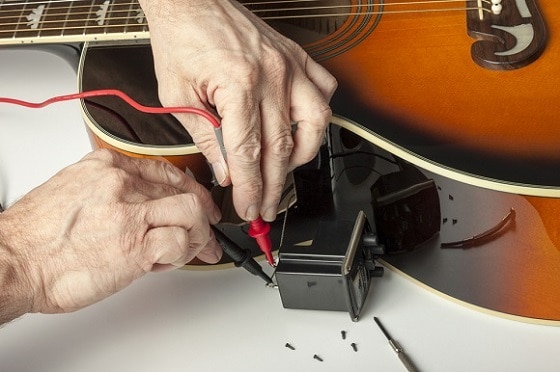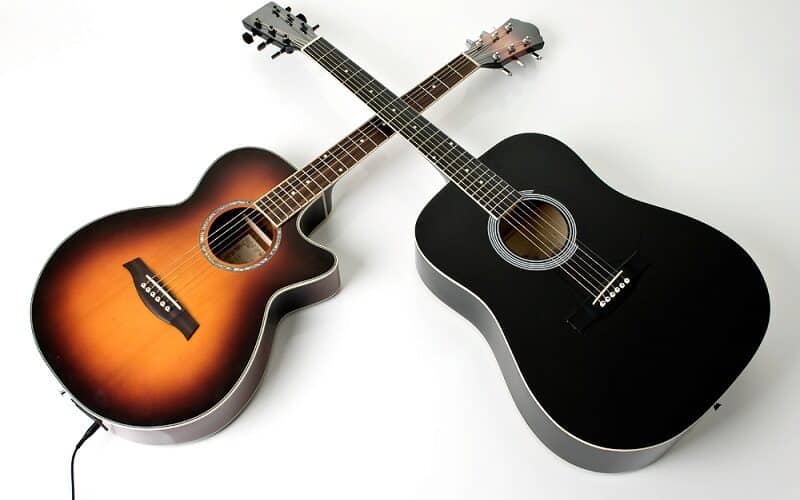Many beginning guitarists start learning on an inexpensive guitar or even a guitar that comes as part of a “starter kit.” While these inexpensive six strings are ideal for learning and practicing the very basics, most of us outgrow them within a year or so.
When the time comes to upgrade to a more serious instrument, the choices can quickly become overwhelming. Should that second guitar be a six-string or seven? Would a solid-body electric guitar serve your purposes, or is a semi-hollow body guitar more your style? And, of course, the dilemma of acoustic vs acoustic electric guitar.
If you’re considering buying your first guitar or making your next guitar an electro-acoustic, but are unsure as to how they differ from standard acoustics and solid-body electrics, this article is for you. Here you’ll know about the difference between acoustic and acoustic-electric guitar.
The Standard Acoustic Guitars
Everybody knows what an acoustic guitar is and what one looks like; that’s because they’ve been around, in one form or another, for hundreds, if not thousands of years.
Tracking the evolution of the modern guitar from earlier stringed instruments is a thorny matter best left to music historians, but most scholars attribute the design of the contemporary acoustic guitar to Spanish luthier Antonio de Torres Jurado, who designed and standardized the instrument in 1850.
The standard acoustic guitar resonates at a very wide range of frequencies, which is why they produce such warm, crisp tones.
One can argue that acoustic guitar has spawned at least two distinct musical genres, blues, and modern folk. Though both styles eventually incorporated the electric guitar to significant effect, purists of both genres still appreciate the undeniable ability of the acoustic guitar to speak directly to one’s soul in a way electric instruments often don’t.
What Is An Electric-Acoustic Guitar?
As its name would imply, an acoustic-electric guitar is an acoustic guitar that can be plugged directly into an amplifier, just like an electric guitar.
The modern acoustic-electric, reintroduced by Bon Jovi to a whole new generation of budding musicians that fateful night in 1989, has come a long way from its initial incarnations. I was surprised to learn that the first commercial acoustic-electric guitar, the ES-150, was initially offered by Gibson as early as 1936.
Surprised as I was to learn this, it makes perfect sense with the benefit of hindsight. By the 1930s, big band was all the rage in the United States, and guitarists all over the country were suddenly finding themselves drowned out by horn sections, pianos, and drums. It wasn’t long before some of the more innovative–and frustrated–of these players began experimenting with ways to amplify their playing.
The first of these experiments involved using telephone transducers and met with minimal success. Efforts to improve on these creative ideas quickly led to the development of the first guitar pickups.
Modern acoustic-electric guitars are practically indistinguishable in looks from a traditional acoustic guitar, though they’re outfitted with a pickup, a quarter-inch jack, and an onboard preamp. Usually, the preamp comes with control sliders for a three-channel equalizer (bass, mid, and treble) and one for volume control.
These days most major guitar manufacturers, including Gibson, Martin, Takamine, Ibanez, and Fender produce lines of electro-acoustic guitars. They come in a number of body styles, including concert, dreadnaught, folk, jumbo, and orchestra.
Are Electro-Acoustics More Versatile?
In a word, yes. In fact, one could argue the acoustic electric’s versatility is its very reason for being. For reasons we’ll discuss in more depth later, the tone produced by an acoustic-electric guitar is no better (and often thinner sounding) than those produced by a microphoned acoustic.

While most purists will stick to a microphoned acoustic for recording clean guitar parts, many will use cool acoustic-electric guitars to play those parts live. This is mostly a matter of convenience; it’s easier to cart around an acoustic-electric than it is to bother with trying to amplify a traditional acoustic for every performance.
Acoustic-electric guitars are also more versatile than regular acoustic guitars when it comes to controlling volume and tone. Raising the volume of an amplified electric acoustic guitar is less likely to result in feedback than increasing the volume of a microphoned guitar.
How To Amplify A Regular Acoustic Guitar?
Suppose you want to amplify your typical acoustic guitar instead of utilizing an electro-acoustic guitar. In that case, you can do so in one of four ways: you can mic the guitar, use a clip-on pickup, use a wireless preamp, or install a permanent pickup.
Microphone

Using a microphone is, sonically speaking, the best way to capture and amplify the sound produced by a normal acoustic guitar. A microphoned acoustic guitar is simply more natural sounding than an amplified acoustic guitar using a pickup and direct line-in.
There are setbacks to amplifying your standard acoustic with a microphone, though. The most significant is that you need to maintain a near-constant distance between the instrument’s soundhole and the microphone. Any deviation as you play can cause the sound to either drop out entirely or become overwhelming.
Wireless Preamp System
Using a wireless preamp is another way to amplify your typical acoustic guitar. Coupled with a receiver that plugs into an amplifier or public address system, a wireless preamp attached to your acoustic picks up the vibrations from the body and wirelessly amplifies them.
Clip-On Pickup System
Also called microphone pickups, clip-on pickups attach easily to the soundhole of your guitar. Having played live many times accompanied by an acoustic amplified this way, I can attest to the fact that clip-on pickups can deliver a quality tone.
Inexpensive and easily portable, clip-on pickups are a great way to amplify a traditional acoustic guitar. As with any guitar pickup, though, a clip-on will only amplify so many of the frequencies produced by the instrument; this is why the acoustic guitar is usually recorded using a microphone.
Install A Pickup
The last way to amplify a traditional acoustic guitar would be to permanently install a pickup. While this is a viable option, I wouldn’t recommend it. Unless you’re an experienced luthier or extremely lucky, you’re liable to damage your beloved guitar by trying to drill the necessary holes.
While not unheard of, installing a pickup in a traditional acoustic guitar seems like a lot of unnecessary work, as a clip-on pickup is less permanent and sounds just as good. And anyway, why is risk mangling your cherished dreadnaught when there are so many reasonably priced, quality electro-acoustic guitars on the market?
Related Article: If you are thinking bout installing a pickup and looking for some suggestions, just check out the detailed review of the best acoustic guitar pickups.
Microphone Vs Onboard Pickup: Tone Quality
If you’ve ever heard a performance during which the performers utilize electro guitars, you may have noticed the difference in tone between them and traditional acoustics. Acoustic-electric guitars are, in fact, just a bit “tinny-sounding” compared to a natural or microphoned acoustic guitar. As touched on above, microphones can pick up a wider range of frequencies than onboard pickups, so some of the sound’s “depth” is lost.
It’s far easier to adjust the tone of an acoustic-electric guitar (or any instrument on a direct line-in) than a microphoned traditional acoustic. Attempting to control the tone and volume of a microphoned acoustic using the equalizer on a P.A. system can prove challenging; often, such attempts result in feedback.
Pros And Cons Of Using Electric-Acoustic Guitars
Pros:
There are many pros to playing an acoustic-electric guitar. For one thing, you don’t have to worry about carrying around and fiddling with clip-on pickups or microphones in order to amplify your traditional acoustic guitar.
Because electric acoustic guitars are plugged directly into an amplifier, it’s relatively easy to adjust their volume and tone. Most guitar amplifiers have bass (low-frequencies,) mid (middle-range frequencies,) and treble (higher-end frequencies) controls.
Acoustic-electric guitars are an excellent compromise for playing live. They provide a more convincing natural acoustic sound than clean solid-body electric guitars, but not quite as natural a sound as a traditional acoustic that’s been microphoned. It’s no wonder that so many famous guitarists choose to play their acoustic parts live on an electro-acoustic.
Cons:
If there’s a con to using an electro-acoustic, it’s that it will sound different, sometimes significantly so, when played with and without amplification. For this reason, it’s best to play an electric acoustic, both amplified and not, before making a purchase.
While it can hardly be considered a con, it should be remembered that an amplified acoustic will never sound the same as an unamplified one. Some of the frequencies produced will be lost to the amplification process.
Acoustic-Electric Vs Acoustic Guitar Comparison: How To Decide?

So how is a beginner guitarist choose between buying an acoustic and an acoustic-electric? The answer, of course, depends on the guitarist. The genre of music the guitarist enjoys, whether the guitarist intends to play primarily alone or with others, and how often the guitarist plans to play live all factor into making the right choice.
For a budding classical guitarist or one enamored with the Delta blues, a traditional acoustic guitar would likely serve them best. Likewise, guitarists who do most of their playing in relatively quiet surroundings will want a standard acoustic, as they’ll be able to enjoy the fuller, richer sounds they produce.
If you’re planning to play live often or enjoy getting together and playing with other musicians, an electric acoustic guitar may be what you’re looking for. Its versatility makes it a great instrument that gives lovers of the acoustic guitar the best of both worlds.
Acoustic-Electric Guitar Versus Acoustic Guitar: Which Is Better For Beginners?
When it comes to which is the better guitar for beginners, one could make just as strong an argument for acoustic electrics as for traditional acoustics. Both guitars have the same basic aesthetic and playability. For absolute beginners, string either guitar with nylon rather than steel, and you’re good to go.
Top rated acoustic-electric guitars have many features that may entice beginning guitarists to practice more often, though, which may give them the edge over traditional acoustics. For one thing, they can be amplified and therefore affected. A delay or chorus pedal can add whole new sonic dimensions to a guitarist’s experience.
An acoustic-electric guitar’s versatility is also perfect for the beginner, who likely is young and has little money to spend on gear.
Ultimately, which guitar is better for a beginner can be argued by honest guitarists. While both are more than suitable for beginners, I’d have to give the acoustic-electric guitar a slight edge.
Cost Of An Acoustic-Electric Guitar
As is the case with most types of guitar, an acoustic-electric guitar can run you anywhere from around one hundred dollars to thousands of dollars, depending on your needs and budget. Cheap acoustic electric guitars are a fair choice and a good option for those who are just starting to learn the instrument.
A beginner guitarist can find a good quality acoustic-electric guitar starter kit for less than two hundred dollars, including an amplifier, cable, and strap.
Guitars are more than mere instruments; every guitarist appreciates the inherent beauty in their design and the craftsmanship that goes into engineering and building even the most humble six-string. Some of the most beautiful guitars on the market today are acoustic electrics, so collectors for whom price is less of an obstacle can find works of art well worth the higher price tag.
Related Article: If you're still unsure which type of guitar to start with, check out our article on 'Acoustic vs Classical Guitar' for a more in-depth comparison between these two popular acoustic guitar styles.
Frequently Asked Questions
What is the difference between acoustic and acoustic electric?
The main difference between acoustic and acoustic-electric guitar is that acoustic guitar uses only acoustical means to produce sound and acoustic-electric guitar uses both acoustic and electric means to create sound.
An acoustic guitar has a soundboard made from a large wooden piece that forms the guitar’s body. The strings are stretched across the soundboard, and when they are plucked or strummed, the soundboard vibrates and produces sound. But without amplification, a regular acoustic guitar slips to deliver an extra loud sound.
An acoustic-electric guitar also has a soundboard and strings. In addition, it has one or more built-in pickups. Pickups are devices that convert string vibrations into electrical signals. Then these signals can be amplified using an amplifier or PA system to produce sound.
Though guitar players can play acoustic-electric guitars without amplification, they are often played with amplification to increase the volume of the sound.
Can you play an acoustic-electric guitar without plugging it in?
Yes, you can play an acoustic-electric guitar without plugging it in. An acoustic-electric guitar has a built-in pickup that senses strings’ vibrations and sends them to an amplifier or PA system.
When you don’t plug an acoustic-electric guitar into an amplifier, then it acts just like a regular acoustic guitar. Just with less resonance and less volume, because without an amp, you have a less powerful system for amplification. When played unplugged, you’ll need to use a microphone to get the best-amplified sound.
Is an electric acoustic guitar easier to play?
The answer is no if you’re asking whether an electric-acoustic guitar is more comfortable to play than a standard acoustic guitar.
There has no other difference between a regular acoustic and electric-acoustic guitar except the presence of a built-in piezo pickup in electric-acoustic guitar for bigger sound projection and tone controls.
Since having some electronic components isn’t directly related to the comfort of guitar playing, the playability of both types of instruments is practically similar.
Do electric acoustic guitars sound the same as acoustic?
Yes, acoustic-electric guitars sound the same as standard acoustics if you play them unplugged because both instruments have the same type of body design. However, if you plug them in, you’ll be able to take advantage of the electro-acoustic amplification function and get a louder sound.
Do acoustic-electric guitars sound good unplugged?
Yes, acoustic-electric guitars sound great when unplugged. The acoustic-electric guitar is a nice acoustic guitar that’s equipped with an electronic pickup, so it can be amplified when needed. But many players enjoy the natural sound of the unplugged acoustic-electric guitar and find that it sounds great without any amplification.


